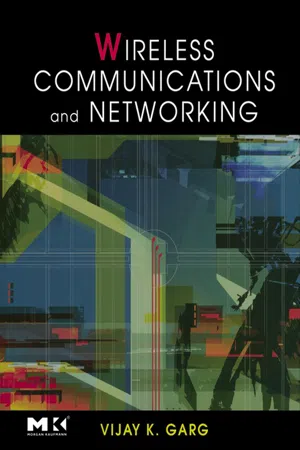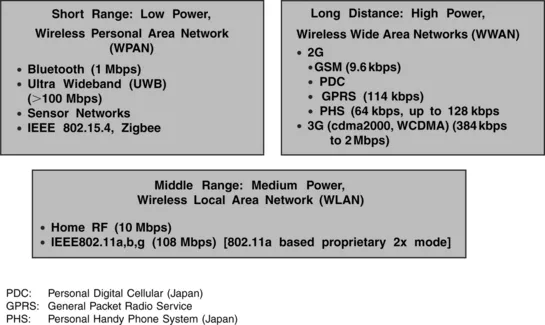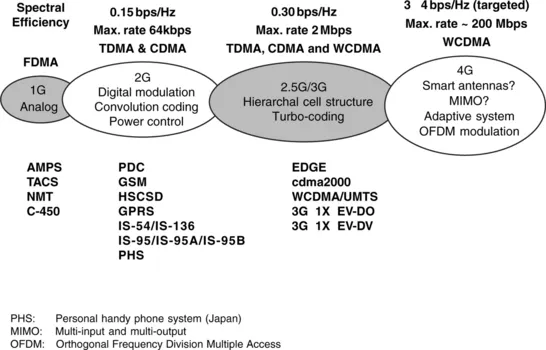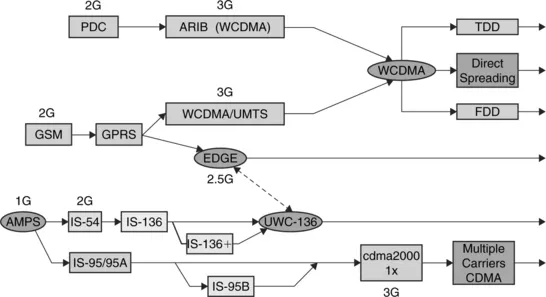1.1 Introduction
The cellular system employs a different design approach than most commercial radio and television systems use [1, 2]. Radio and television systems typically operate at maximum power and with the tallest antennas allowed by the regulatory agency of the country. In the cellular system, the service area is divided into cells. A transmitter is designed to serve an individual cell. The system seeks to make efficient use of available channels by using low-power transmitters to allow frequency reuse at much smaller distances. Maximizing the number of times each channel can be reused in a given geographic area is the key to an efficient cellular system design.
During the past three decades, the world has seen significant changes in the telecommunications industry. There have been some remarkable aspects to the rapid growth in wireless communications, as seen by the large expansion in mobile systems. Wireless systems consist of wireless wide-area networks (WWAN) [i.e., cellular systems], wireless local area networks (WLAN) [4], and wireless personal area networks (WPAN) (see Figure 1.1) [17]. The handsets used in all of these systems possess complex functionality, yet they have become small, low-power consuming devices that are mass produced at a low cost, which has in turn accelerated their widespread use. The recent advancements in Internet technology have increased network traffic considerably, resulting in a rapid growth of data rates. This phenomenon has also had an impact on mobile systems, resulting in the extraordinary growth of the mobile Internet.
Wireless data offerings are now evolving to suit consumers due to the simple reason that the Internet has become an everyday tool and users demand data mobility. Currently, wireless data represents about 15 to 20% of all air time. While success has been concentrated in vertical markets such as public safety, health care, and transportation, the horizontal market (i.e., consumers) for wireless data is growing. In 2005, more than 20 million people were using wireless e-mail. The Internet has changed user expectations of what data access means. The ability to retrieve information via the Internet has been “an amplifier of demand” for wireless data applications.
More than three-fourths of Internet users are also wireless users and a mobile subscriber is four times more likely to use the Internet than a nonsubscriber to mobile services. Such keen interest in both industries is prompting user demand for converged services. With more than a billion Internet users expected by 2008, the potential market for Internet-related wireless data services is quite large.
In this chapter, we discuss briefly 1G, 2G, 2.5G, and 3G cellular systems and outline the ongoing standard activities in Europe, North America, and Japan. We also introduce broadband (4G) systems (see Figure 1.2) aimed on integrating WWAN, WLAN, and WPAN. Details of WWAN, WLAN, and WPAN are given in Chapters 15 to 20.
1.2 First- and Second-Generation Cellular Systems
The first- and second-generation cellular systems are the WWAN. The first public cellular telephone system (first-generation, 1G), called Advanced Mobile Phone System (AMPS) [8, 21], was introduced in 1979 in the United States. During the early 1980s, several incompatible cellular systems (TACS, NMT, C450, etc.) were introduced in Western Europe. The deployment of these incompatible systems resulted in mobile phones being designed for one system that could not be used with another system, and roaming between the many countries of Europe was not possible. The first-generation systems were designed for voice applications. Analog frequency modulation (FM) technology was used for radio transmission.
In 1982, the main governing body of the European post telegraph and telephone (PTT), la Conférence européenne des Administrations des postes et des télécommunications (CEPT), set up a committee known as Groupe Special Mobile (GSM) [9], under the auspices of its Committee on Harmonization, to define a mobile system that could be introduced across western Europe in the 1990s. The CEPT allocated the necessary duplex radio frequency bands in the 900 MHz region.
The GSM (renamed Global System for Mobile communications) initiative gave the European mobile communications industry a home market of about 300 million subscribers, but at the same time provided it with a significant technical challenge. The early years of the GSM were devoted mainly to the selection of radio technologies for the air interface. In 1986, field trials of different candidate systems proposed for the GSM air interface were conducted in Paris. A set of criteria ranked in the order of importance was established to assess these candidates.
The interfaces, protocols, and protocol stacks in GSM are aligned with the Open System Interconnection (OSI) principles. The GSM architecture is an open architecture which provides maximum independence between network elements (see Chapter 7) such as the Base Station Controller (BSC), the Mobile Switching Center (MSC), the Home Location Register (HLR), etc. This approach simplifies the design, testing, and implementation of the system. It also favors an evolutionary growth path, since network element independence implies that modification to one network element can be made with minimum or no impact on the others. Also, a system operator has the choice of using network elements from different manufacturers.
GSM 900 (i.e., GSM system at 900 MHz) was adopted in many countries, including the major parts of Europe, North Africa, the Middle East, many east Asian countries, and Australia. In most of these cases, roaming agreements exist to make it possible for subscribers to travel within different parts of the world and enjoy continuity of their telecommunications services with a single number and a single bill. The adaptation of GSM at 1800 MHz (GSM 1800) also spreads coverage to some additional east Asian countries and some South American countries. GSM at 1900 MHz (i.e., GSM 1900), a derivative of GSM for North America, covers a substantial area of the United States. All of these systems enjoy a form of roaming, referred to as Subscriber Identity Module (SIM) roaming, between them and with all other GSM-based systems. A subscriber from any of these systems could access telecommunication services by using the personal SIM card in a handset suitable to the network from which coverage is provided. If the subscriber has a multiband phone, then one phone could be used worldwide. This globalization has positioned GSM and its derivatives as one of the leading contenders for offering digital cellular and Personal Communications Services (PCS) worldwide. A PCS system offers multimedia services (i.e., voice, data, video, etc.) at any time and any where. With a three band handset (900, 1800, and 1900 MHz), true worldwide seamless roaming is possible. GSM 900, GSM 1800, and GSM 1900 are second-generation (2G) systems and belong to the GSM family. Cordless Telephony 2 (CT2) is also a 2G system used in Europe for low mobility.
Two digital technologies, Time Division Multiple Access (TDMA) and Code Division Multiple Access (CDMA) (see Chapter 6 for details) [10] emerged as clear choices for the newer PCS systems. TDMA is a narrowband technology in which communication channels on a carrier frequency are apportioned by time slots. For TDMA technology, there are three prevalent 2G systems: North America TIA/EIA/IS-136, Japanese Personal Digital Cellular (PDC), and European Telecommunications Standards Institute (ETSI) Digital Cellular System 1800 (GSM 1800), a derivative of GSM. Another 2G system based on CDMA (TIA/EIA/IS-95) is a direct sequence (DS) spread spectrum (SS) system in which the entire bandwidth of the carrier channel is made available to each user simultaneously (see Chapter 11 for details). The bandwidth is many times larger than the bandwidth required to transmit the basic information. CDMA systems are limited by interference produced by the signals of other users transmitting within the same bandwidth.
The global mobile communications market has grown at a tremendous pace. There are nearly one billion users worldwide with two-thirds being GSM users. CDMA is the fastest growing digital wireless technology, increasing its worldwide subscriber base significantly. Today, there are already more than 200 million CDMA subscribers. The major markets for CDMA technology are North America, Latin America, and Asia, in particular Japan and Korea. In total, CDMA has been adopted by almost 50 countries around the world.
The reasons behind the success of CDMA are obvious. CDMA is an advanced digital cellular technology, which can offer six to eight times the capacity of analog technologies (AMP) and up to four times the capacity of digital technologies such as TDMA. The speech quality provided by CDMA systems is far superior to any other digital cellular system, particularly in difficult RF environments such as dense urban areas and mountainous regions. In both initial deployment and long-term operation, CDMA provides the most cost effective solution for cellular operators. CDMA technology is constantly evolving to offer customers new and advanced services. The mobile data rates offered through CDMA phones have increased and new voice codecs provide speech quality close to the fixed wireline. Internet access is now available through CDMA handsets. Most important, the CDMA network offers operators a smooth migration path to third-generation (3G) mobile systems, [3, 5, 7, 11].
1.3 Cellular Communications from 1G to 3G
Mobile systems have seen a change of generation, from first to second to third, every ten years or so (see Figure 1.3). At the introduction of 1G services, the mobile device was large in size, and would only fit in the trunk of a car. All analog components such as the power amplifier, synthesizer, and shared antenna equipment were bulky. 1G systems were intended to provide voice service and low rate (about 9.6 kbps) circuit-switched data services. Miniaturization of mobile devices progressed before the introduction of 2G services (1990) to the point where the size of mobile phones fell below 200 cubic centimeters (cc). The first-generation handsets provided poor voice quality, low talk-time, and low standby time. The 1G systems used Frequency Division Multiple Access (FDMA) technology (see Chapter 6) and analog frequency modulation [8, 20].
The 2G systems based on TDMA and CDMA technologies [6] were primarily designed to improve voice quality and provide a set of rich voice features. These systems supported low rate data services (16–32 kbps).
For second-generation systems three major problems impacting system cost and quality of service remained unsolved. These include what method to use for band compression of voice, whether to u...



